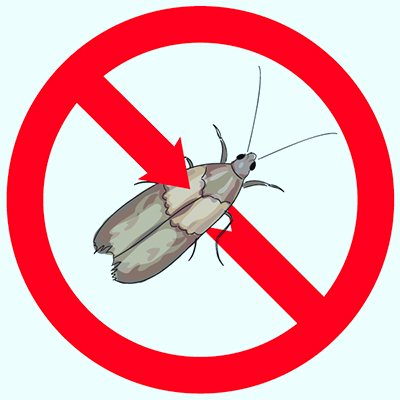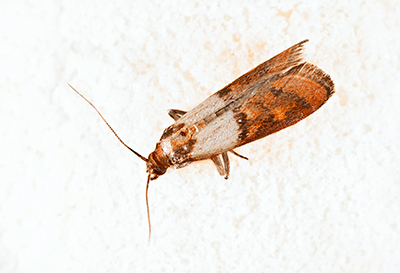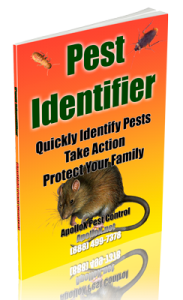Pantry Moth Extermination – Why Bother?
 Put simply, pantry moths destroy food. They rapidly multiply and as their larvae eat through the food in a container whether it be a bag of flour, a cereal box or a box of oatmeal, they leave grow, molt and leave old skin casings, fras and waste on the top 2 inches or so of the food container. The food inside is no longer edible.
Put simply, pantry moths destroy food. They rapidly multiply and as their larvae eat through the food in a container whether it be a bag of flour, a cereal box or a box of oatmeal, they leave grow, molt and leave old skin casings, fras and waste on the top 2 inches or so of the food container. The food inside is no longer edible.
Pantry Moth Extermination – Signs You Have Pantry Moths
The first sign you have pantry moths will often be sighting one or more moths flying around the kitchen, mostly at night seeking light or a mate. The moths are about a half inch long with a 5/8 inch wingspan. The two main types of pantry moth are the Indian Meal Moth which is gray with a redish tint on the rear area, and the Mediterranean Flour Moth which is alternately gray and buff white with no coloring.
For every adult moth you see flying around the kitchen, there are likely hundreds of eggs and larvae somewhere living in one or more food containers. Any open food source like a bag of flour or a cereal box is suspect. Dry food that has been sitting around in the back of your shelf for a long time is especially susceptible to pantry moth infestation. The sight of cocoon webbing around the edges of cupboards and food storage areas, or worm-like moth larvae verify the presence of the moths. You may even notice a moth flying out of a cereal box as it is opened.
Closer inspection may reveal the presence of moth eggs which are only 1 to 2 hundreths of an inch and grayish white in color. The larvae are small ½ inch long 5 legged caterpillars and are off white, depending on the food source. They may vary in color to green to pale pink or brown.
Pantry Moth Extermination – Their Life Cycle
 It takes from 30 to 300 days for one moth to multiply to 400 moths. The cycle goes faster if it’s warmer, and there is a good food source. Do the math: Let’s be conservative and say the cycle takes 150 days. In six months you might have 400 moths, and in a year 200 X 400 = 80,000 moths (only the females lay eggs)! Your kitchen is completely trashed!
It takes from 30 to 300 days for one moth to multiply to 400 moths. The cycle goes faster if it’s warmer, and there is a good food source. Do the math: Let’s be conservative and say the cycle takes 150 days. In six months you might have 400 moths, and in a year 200 X 400 = 80,000 moths (only the females lay eggs)! Your kitchen is completely trashed!
The Eggs: The pantry moth life cycle begins when an adult female lays up to 400 eggs, typically directly on the food source. The eggs hatch in about 7 days and the larvae emerge.
The Larva: The larva is the only stage of pantry moth development that eats. Their one goal in life is to eat and gain bulk. It takes them about 42 to 56 days and 5 stages of development, each stage ending by shedding their skin which collects at the top of the food container along with their waste.
The Pupae: The pupae are from ¼ to 1/3rd inch long. You’ll see them in the open or in cocoon webbing. Look especially in tight spots such as crevices in pantry shelves or doorway seams. The pupae continue to develop to adulthood for about 15-20 days.
The Adult: Adult moths emerge from the pupae looking for a mate and having a mission to reproduce about 400 moths. The female releases a pheromone scent to attract the male. At this stage you’re likely to see a few moths flying around the kitchen at night. The adults live for up to 2 weeks.
Pantry Moth Extermination – Seek and Destroy
You can be a meticulous cleaner and still get a pantry moth infestation, because the tiny moth eggs may already be in the dry foods you bring home from the grocery store. So, be easy on yourself and focus on the solution which begins with seeking points of infestation.
Pull all food containers off your pantry shelves, so that the shelves are completely empty. Then inspect each container one by one.
What to inspect? Check every box, bag or package of food, whether sealed or open. All edible food is suspect. For example, inspect dried flowers, children’s macaroni art, pasta, pet treats, dog biscuits. Inspect every can and jar in the kitchen. Look for moth webbing under the lips of jar lids and on the rims of cans.
As you discover infested food, dispose of it immediately. Tightly seal all infested food items in trash bags and get them out of the house and garage. Don’t even think of saving part of the food in an infested container. The whole container is infested.
If webbing is found on an unopened can or jar, wash it thoroughly with a 50/50 mixture of white vinegar and warm water.
Now, before returning the cleaned, non-infested food containers to the pantry, vacuum the pantry out (and dispose of the vacuum bag in one of those sealed trash bags as noted above). Then, wash down the pantry shelves with that 50/50 water vinegar mixture. Also, wash down every surface in the kitchen from walls to floors and even in places like door jams – a favorite hiding place for moth eggs. Don’t forget to wash the garbage containers and pet food dishes and containers.
Finally, tightly seal all food. Remember, female moths lay eggs directly on food. If they can’t find exposed food, they have no place to lay their eggs.
Pantry Moth Extermination – Moth Control Techniques
Pheromone Traps:
If you’re following all of the above suggestions and thoroughly cleaning everything, yet still have a moth problem, you might try pheromone moth traps. This is safe and completely non-toxic. The pheromone scent in the trap attracts the male moths, and the stick surface traps them. With the male moths out of the picture, reproduction can’t take place. This gives your pantry cleaning efforts (above) a better chance of success.
Bay Leaves:
Place a few bay leaves in your cleaned pantry shelves to help deter any moths that might be lurking about the house.
Pantry Moth Extermination: Hire a Pest Control Professional
If your pantry moth problem persists, or if you simply don’t have the time or desire to conduct the thorough measures outlined above, we understand completely. That’s a huge task.
A quicker, alternate approach is to hire a pest control professional like ApolloX Pest Control, the pantry moth experts. We’ll thoroughly inspect your home and likely discover places you would never have imagined moths, eggs, larvae or pupae could be hiding. While we’re at it, we’ll also inspect for the presence of other pests like mice, cockroaches, ants, termites and others. Our goal is that your home and the area around your home be entirely pest-free.












Recent Comments